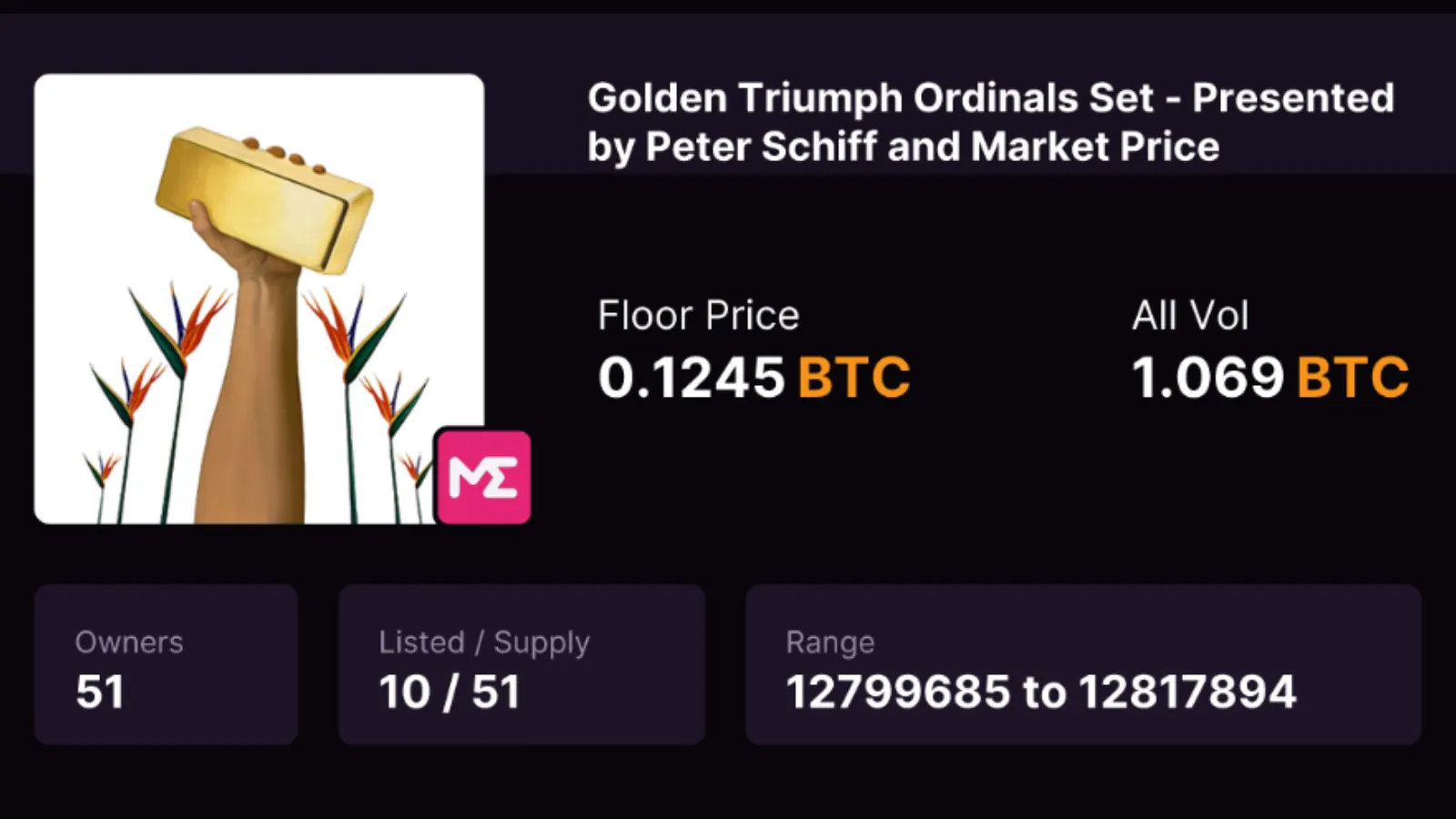Coins
Cardano’s Chang Hard Fork Introduces On-Chain Governance
Published
3 months agoon
By
admin

On Sept. 1 at 21:44 UTC, layer-1 blockchain Cardano executed the ‘Chang’ hard fork at block 10,764,778, entering the “Voltaire Era” and introducing on-chain governance using its native token ADA.
Following the hard fork, ADA token holders now have the power to elect representatives and vote on key development proposals.
According to the Cardano roadmap, the Voltaire era “will provide the final pieces required for the Cardano network to become a self-sustaining system.” It added that the introduction of a voting and treasury system will enable network participants to “use their stake and voting rights to influence the future development of the network.”
Not mincing his words, Cardano co-founder Charles Hoskinson lauded the hard fork as “one of the greatest technical achievements in human history.”
In a tweet, the Cardano Foundation wrote that the hard fork “marks a major milestone for the Cardano blockchain, ecosystem, and community––fulfilling the promise of a truly self-governing, decentralized network.”
Today’s Chang hard fork marks a major milestone for the Cardano blockchain, ecosystem, and community––fulfilling the promise of a truly self-governing, decentralized network.
Welcome to a new era of decentralized governance: Voltaire. ⚖️ https://t.co/sE0iyRKLg9 pic.twitter.com/dA0JkgYOio
— Cardano Foundation (@Cardano_CF) September 2, 2024
What is a hard fork?
A hard fork occurs when changes are made to a blockchain’s rules, resulting in a new, parallel blockchain that runs alongside the original. Cardano’s latest hard fork is named in honor of Phil Chang, the executive who spearheaded the Voltaire initiative at IOHK.
Under Cardano’s new governance model, the Cardano Foundation, Input Output Global (IOHK), and Emurgo no longer hold exclusive authority over decisions related to hard forks and other major upgrades.
The CIP-1694 lays out that three key bodies will form the foundation of Cardano’s new governance model: the constitutional committee (CC), delegate representatives (Dreps), and stake pool operators (SOPs).
The Chang hard fork is being rolled out in two phases. The first phase, currently live, introduced the constitutional committee, responsible for overseeing the governance transition.
Phase 2 will introduce DReps, letting ADA holders delegate their voting power to streamline governance, along with an on-chain voting system, all set for full implementation by 2025.
The hard fork also triggered the activation of Plutus v3, which delivers advanced smart contract efficiency, cryptographic primitives, and governance integrations.
However, the much-anticipated upgrade couldn’t prevent Cardano’s price from sinking alongside the wider crypto market, with ADA slipping by 2.6% over the past 24 hours, per data from CoinGecko.
Daily Debrief Newsletter
Start every day with the top news stories right now, plus original features, a podcast, videos and more.
Source link
You may like


Solana Hits New ATH On Huge Whale Accumulation, More Gains Ahead?


Microsoft Should Buy $78 Billion Worth of Bitcoin


Ethereum Believers May Be Staring Down Opportunity As ETH Reaches Another Low Against Bitcoin: CryptoQuant CEO


UK government is ready for crypto regulations next year


“Crypto Dad” Chris Giancarlo Emerges Top For White House Crypto Czar Role


Bitcoin Nears $100,000 As Trump Council Expected To Implement BTC Reserve
Coins
Justin Sun Goes Bananas: Snags Controversial “Comedian” Artwork for $6.4 Million
Published
23 hours agoon
November 21, 2024By
admin

What’s worth millions, taped to a wall, and destined to rot? Hint: It’s art you can’t hang for long.
Maurizio Cattelan’s infamous duct-taped banana art piece, Comedian, fetched an eye-popping $6.24 million, including fees, at Sotheby’s contemporary art auction in New York on Wednesday night.
The sale saw six bidders battle it out before Jen Hua, deputy chairman of Sotheby’s and chairman of Sotheby’s China, placed the winning bid on Tron founder Justin Sun’s behalf.
The artwork shattered its $1.5 million pre-sale estimate and became its place as one of the most expensive—and controversial—art pieces (or should we say fruit) ever.
Sotheby’s accepted crypto payments for this sale as the market is seeing new heights following Donald Trump’s re-election, with Bitcoin (BTC) soaring to $97,000 on Wednesday.
The crypto entrepreneur, Sun, claimed the artwork in a heated five-minute bidding war that involved six other participants.
After over 6 minutes of heated bidding, Deputy Chairman of Sotheby’s and Chairman of Sotheby’s China, Jen Hua, placed the winning bid for ‘Comedian’ on behalf of @justinsuntron, Chinese collector and founder of cryptocurrency platform TRON. https://t.co/Vf6kMoHfOQ
— Sotheby’s (@Sothebys) November 21, 2024
“This is not just an artwork; it represents a cultural phenomenon that bridges the worlds of art, memes, and the cryptocurrency community,” Sun wrote on X, sharing his “banana” experience.
He announced plans to eat the banana in the coming days as part of what he described as “honoring its place in both art history and popular culture.”
The artwork comprises a real banana affixed to a wall with duct tape, accompanied by a certificate of authenticity and instructions for replacing the fruit as it inevitably decays.
During the heated auction, Sotheby’s auctioneer Oliver Barker quipped, “These are the words I never thought I’d say, ‘$5 million for a banana.’”
The banana’s rise to infamy in the art scene began in 2019 when one sold for $120,000 at Art Basel. The work became a viral sensation after performance artist David Datuna ate the banana, dubbing his act “Hungry Artist.”
Since then, Comedian has sparked conversations about the absurdity and subjectivity of art valuation.
Justin Sun founded the blockchain platform Tron in 2017. In December 2021, he stepped down as CEO of the Tron Foundation, claiming he had transferred control of the project to Tron DAO, a non-profit decentralized autonomous organization.
Edited by Sebastian Sinclair
Daily Debrief Newsletter
Start every day with the top news stories right now, plus original features, a podcast, videos and more.
Source link
Coins
McDonald’s Reveals Doodles Collab for Coffee and Collectibles
Published
1 week agoon
November 14, 2024By
admin

The golden arches are getting a pastel makeover for the holiday season.
Fast food giant McDonald’s and Web3-native brand Doodles revealed a collaboration Thursday, featuring custom cups that showcase the Ethereum NFT collection’s colorful, hand drawn style. On top of that, customers can unlock digital collectibles and content, as well as access co-branded physical merchandise.
Dubbed the “GM Spread Joy” campaign, the marketing initiative is being billed as an immersive experience that pays homage to the Crypto Twitter mantra. Available to customers in the U.S., the promotion can be accessed at participating stores among McDonald’s 13,500 restaurants.
The limited-edition cups, emblazoned with pinks and blues amid holiday-themed tableaus, allow customers to access a “pack ripping” experience, McDonald’s said in a press release.
Dovetailing with Doodles’ digital avatars, they contain accessories and apparel for Doodles characters, among other goodies, like access to music videos and Doodles’ animated series. In addition to the original Ethereum NFT collection, Doodles has launched an avatar creation “Stoodio” app on Ethereum layer-2 network Base, where the digital items can be used.
Outside the U.S., where NFT projects haven’t faced intense regulatory scrutiny, the burger chain has used NFTs to promote its purple icon Grimace and launched a metaverse game called My Happy Place. What’s more, McDonald’s tapped The Sandbox, an Ethereum-based metaverse game, to pay tribute to its chicken nuggets.
McDonald’s collaboration with Doodles may represent its biggest step into the NFT space since its American division unveiled McRib-inspired NFTs in 2021. Effectively, McDonald’s was an early adopter of using digital assets as a way to reward customers and cultivate brand loyalty.
Earlier this year, Doodles teamed up with the sportswear powerhouse Adidas, introducing virtual swag packs that let buyers claim exclusive physical apparel. As Doodles’ Chief Brand Officer, some collectibles paid homage to a song created with musician Pharrell Williams.
As part of its holiday promotion, McDonald’s customers can access a track produced by Williams called “Good Mornin,” sung by artist Marley Bleu. Williams, who once worked at McDonald’s, was inspired by internet culture and “viral ‘GM’ memes,” McDonald’s said.
Comprising 10,000 generative profile pictures (PFPs), Doodles features art by Scott “Burnt Toast” Martin. The collection is currently valued at 20,296 ETH ($64 million), according to CoinGecko, with the cheapest NFT from the collection listed for 2 ETH ($6,300) on secondary markets.
Known as the collection’s floor price, the figure climbed as high as 2.7 ETH ($8,500) earlier this week after McDonald’s teased the collaboration on Twitter (aka X).
Edited by Andrew Hayward
Daily Debrief Newsletter
Start every day with the top news stories right now, plus original features, a podcast, videos and more.
Source link
Coins
Gold Bug Peter Schiff Urges Traders to Buy His Ordinals Amid Bitcoin’s Surge
Published
1 week agoon
November 11, 2024By
admin
With Bitcoin surpassing all-time highs by the hour, even noted Bitcoin skeptic Peter Schiff is trying to get in on the action by selling his Ordinals collection.
On Sunday, the financial commentator and radio host said on X (formerly Twitter) that the Peter Schiff Ordinals collection, also known as the Golden Triumph Ordinals Set, would go up for sale on Magic Eden.
Bitcoin surged past $80,000 Sunday in the crypto-optimistic wake of Donald Trump’s election victory last week. It has since passed the $87,000 mark.
Launched in 2023, the “Golden Triumph Ordinals Set” is a collection of 51 Ordinal inscriptions on the Bitcoin Blockchain. Similar to a non-fungible token (NFT), a Bitcoin Ordinal is a digital collectible on the Bitcoin blockchain. Each Ordinal is inscribed on an individual satoshi, the smallest denomination of a Bitcoin. Ordinals have included text, images, video clips, and even video games on the Bitcoin network.
The current floor price for one of the Schiff NFTs is 0.1245 BTC, around $10,774 for each collectible, according to Magic Eden data. Despite having a low trading volume, the Schiff NFTs rose 149% last year with an original price of 0.05 BTC, around $1,885.
“There’s 21 million Bitcoin but only 50 Golden Triumph ordinals. It’s clear which one is more valuable,” Schiff tweeted. “You can’t argue with math.”
It’s unclear if Schiff is attempting to profit from Bitcoin mania. The gold bug did not immediately return a request for comment.

Crypto Twitter reacted to Schiff’s tweet with a mix of surprise and skepticism.
Peter, it’s very clear that your bearish sentiment about Bitcoin (which has been wrong) is a great engagement farming strategy. I have to give it to you.
But it’s time for you to join us for real 🤗
— Jan | BIP-420🐱 (@nonfungible_jan) November 11, 2024
Despite Schiff announcing the sale of the Ordinals collection, he claimed not to own a Bitcoin wallet himself or ownership of the collection.
“The ordinals belong to the people who bought them in the original auction,” he said.
No me. Whoever sells their ordinal gets your Bitcoin. I don’t even have a wallet.
— Peter Schiff (@PeterSchiff) November 10, 2024
When asked why someone would part with the increasingly valuable Bitcoin for one of his NFTs, Schiff said it was because of scarcity.
“Why is Bitcoin more valuable,” Schiff said. “The Golden Triumph originals are way more scarce than Bitcoin.”
Schiff has consistently argued that gold is a better investment than Bitcoin, comparing it to Tulip mania.
On Monday, he decried Trump’s vow to establish a Bitcoin Reserve, prognosticating that such a move would cause a massive market meltdown.
“To maintain the pretense that its Bitcoin reserve has actual value, the U.S. government would be forced to keep buying, destroying the value of the dollar in the process.” he tweeted.
If the U.S. government actually established a #Bitcoin reserve and bought 1 million Bitcoin, it might end up buying millions more. Since the U.S. government’s purchase of 1 million Bitcoin would drive the price so high, many HODLers, then worth millions or billions, would finally…
— Peter Schiff (@PeterSchiff) November 11, 2024
In any case, it appears as though Schiff wants a piece of the action after more than a decade of denial. Welcome aboard.
Edited by Sebastian Sinclair and Josh Quittner
Daily Debrief Newsletter
Start every day with the top news stories right now, plus original features, a podcast, videos and more.
Source link

Solana Hits New ATH On Huge Whale Accumulation, More Gains Ahead?

Microsoft Should Buy $78 Billion Worth of Bitcoin

Ethereum Believers May Be Staring Down Opportunity As ETH Reaches Another Low Against Bitcoin: CryptoQuant CEO

UK government is ready for crypto regulations next year

“Crypto Dad” Chris Giancarlo Emerges Top For White House Crypto Czar Role

Bitcoin Nears $100,000 As Trump Council Expected To Implement BTC Reserve

Know Your Missiles: Russia’s Experimental Hypersonic Missile Is A New Kind of Killing Machine

Polkadot investor predicts a 30,000% rally for this $0.04 token by 2025

Donald Trump Proposed Crypto Advisory Council To Set Up Strategic Bitcoin Reserve

Want Greater Bitcoin Adoption? Engage With Your Government.

Why the Media Loves the Worst of Crypto

HashCats prepares for Token Generation Event after completing mining season

Gary Gensler To Step Down As US SEC Chair In January

The Chart That Shows Bitcoin’s Bull Run Won’t Stop at $100,000

$2 Million PEPE Purchase Sees 105 Billion Tokens Snapped Up
182267361726451435

Top Crypto News Headlines of The Week

Why Did Trump Change His Mind on Bitcoin?

New U.S. president must bring clarity to crypto regulation, analyst says

Ethereum, Solana touch key levels as Bitcoin spikes

Bitcoin Open-Source Development Takes The Stage In Nashville

Will XRP Price Defend $0.5 Support If SEC Decides to Appeal?

Bitcoin 20% Surge In 3 Weeks Teases Record-Breaking Potential

Ethereum Crash A Buying Opportunity? This Whale Thinks So

Shiba Inu Price Slips 4% as 3500% Burn Rate Surge Fails to Halt Correction

‘Hamster Kombat’ Airdrop Delayed as Pre-Market Trading for Telegram Game Expands

Washington financial watchdog warns of scam involving fake crypto ‘professors’

Citigroup Executive Steps Down To Explore Crypto
Mostbet Güvenilir Mi – Casino Bonus 2024

Bitcoin flashes indicator that often precedes higher prices: CryptoQuant
Trending

 2 months ago
2 months ago182267361726451435

 24/7 Cryptocurrency News3 months ago
24/7 Cryptocurrency News3 months agoTop Crypto News Headlines of The Week

 Donald Trump4 months ago
Donald Trump4 months agoWhy Did Trump Change His Mind on Bitcoin?

 News3 months ago
News3 months agoNew U.S. president must bring clarity to crypto regulation, analyst says

 Bitcoin4 months ago
Bitcoin4 months agoEthereum, Solana touch key levels as Bitcoin spikes

 Opinion4 months ago
Opinion4 months agoBitcoin Open-Source Development Takes The Stage In Nashville

 Price analysis3 months ago
Price analysis3 months agoWill XRP Price Defend $0.5 Support If SEC Decides to Appeal?

 Bitcoin4 months ago
Bitcoin4 months agoBitcoin 20% Surge In 3 Weeks Teases Record-Breaking Potential


